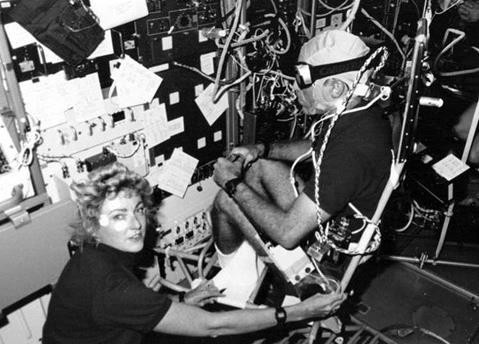STS-40
|
Int. Designation |
1991-040A |
|
Launched |
5 June 1991 |
|
Launch Site |
Pad 39B, Kennedy Space Center, Florida |
|
Landed |
14 June 1991 |
|
Landing Site |
Runway 22, Edwards AFB, California |
|
Launch Vehicle |
OV-102 Columbia/ET-41/SRB BI-044/SSME #1 2015; #2 2022; #3 2027 |
|
Duration |
9 days 2 hrs 14min 20 sec |
|
Call sign |
Columbia |
|
Objective |
Spacelab Life Sciences-1 payload operations (18 experiments) |
Flight Crew
O’CONNOR, Bryan Daniel, 44, USMC, commander, 2nd mission Previous mission: STS 61-B (1985)
GUTIERREZ, Sidney McNeill, 39, USAF, pilot
BAGIAN, James Phillip, 39, civilian, mission specialist 1, 2nd mission
Previous mission: STS-29 (1989)
JERNIGAN, Tamara Elizabeth, 32, civilian, mission specialist 2 SEDDON, Margaret Rhea, 43, civilian, mission specialist 3, 2nd mission Previous mission: STS 51-D (1985)
GAFFNEY, Francis Andrew “Drew”, 44, civilian, payload specialist 1 HUGHES-FULFORD, Millie Elizabeth, 46, civilian, payload specialist 2
Flight Log
The launch, originally set for 22 May, was postponed less than 48 hours beforehand due to the discovery of a leaking LH transducer in the orbiter MPS. This was removed and replaced during a leak test in 1990. Then, one of the five General Purpose Computers (GPC) failed, along with one of the multiplexer-demultiplexers that control orbiter hydraulics ordnance and OMS/RCS functions in the aft compartment. One LH and two LO transducers were replaced in the propellant flow system and three LO transducers were replaced in the manifold area, while three further LH transducers were removed and the opening plugged. The rescheduled launch for 1 June was again postponed, despite several attempts to calibrate IMU 2. After it was replaced and tested, the launch was rescheduled again, this time for 5 June. This launch proceeded without incident.
The crew worked a single-shift system to complete the research programme. The primary objectives of the mission’s 18 investigations required a larger crew than normal. In addition to the seven astronauts (and one mannequin), there were also
|
Bagian is in a rotating chair, wearing an accelerometer and electrodes to record head motion and horizontal and vertical eye movements during rotation. This vestibular experiment activity is monitored and assisted by Hughes-Fulford |
2,478 jellyfish and 29 lab rats. The humans were involved in ten investigations, with a further seven involving the rodents and one with the jellyfish. In the most detailed and interrelated physiological measurements made on US astronauts since Skylab in 1973/74, the investigations on the crew focused on seven human body systems: the cardiovascular/cardiopulmonary, haematological, muscular, skeletal, vestibular, immune and renal-endocrine systems. The research also included pre- and post-flight medical studies on the crew. In one of these pre-flight investigations, a catheter was inserted into a vein of PS Gaffney before the flight and advanced to a point near his heart. This was designed to monitor blood pressure changes upon his arrival on orbit.
The rats were contained in two groups, one located in the Animal Enclosure Modules (AEM) on the mid-deck of Columbia and the other in a Research Animal Holding Facility (RAHF) in the Spacelab module. The rodents were used for research into muscle, bone and inner-ear functions and for certification of the holding facilities for future use. The jellyfish were encased in flasks and bags filled with artificial seawater. They were filmed to observe their swimming motions for later comparison with a control group on Earth. The crew also evaluated the workstations, the glove box, the medical restraint system and the intravenous pump for future Spacelab and space station use.
Thanks to careful use of their available electrical power, the crew were able to gain an extra flight day in order to continue to collect data. They also continued the programme of photography of the Earth’s features, including taking video of the 19 km high yellowish ash plume erupting from Mount Pinatubo in the Philippines during the mission. The twelve Getaway Special (GAS) experiments in the payload bay included research into forming ball bearings, crystal growth and ultra light metals in space; soldering in space; and studying the effects of cosmic particles on computer disks to determine their impact on data storage. Early in the mission, it was thought that a piece of material on the port side payload bay door (used to protect the payload bay from dust contamination on the ground) might interfere with nominal door closing. Bagian and Jernigan would have performed the EVA if required, but ground-based studies concluded there was no hazard and the doors closed properly. After the mission, the astronauts continued to participate in a variety of medical tests. Seddon, Bagian, Gaffney and Hughes-Fulford remained at Edwards for an additional week of medical tests after the rest of the crew returned to Houston.
Milestones
142nd manned space flight
71st US manned space flight
41st flight of Space Shuttle
11th flight of Columbia
1st Spacelab Life Science mission
5th dedicated Spacelab mission
4th flight of Spacelab Long Module configuration
1st flight of payload specialists since STS-51L
Gaffney celebrates his 45th birthday in space (6 Jun)











